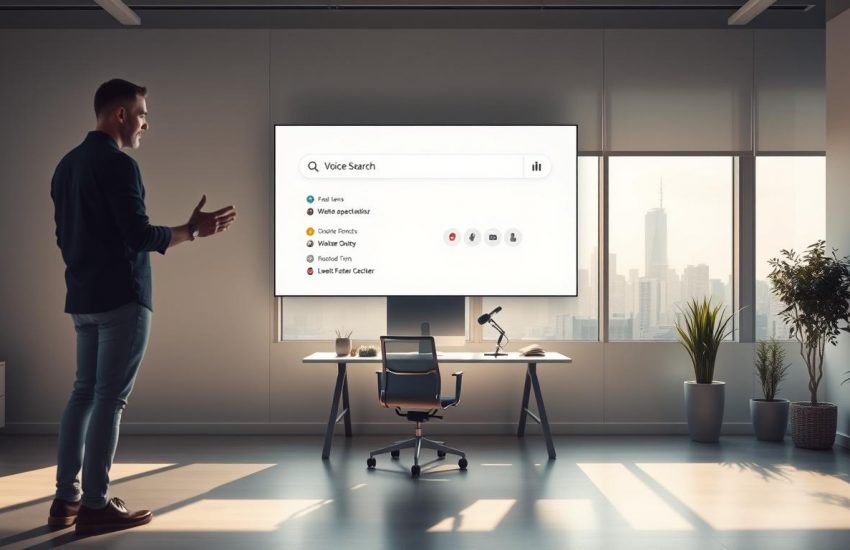We introduce how conversational AI is changing how people find answers aloud. Today, 28% of consumers in the US and UK use assistants daily. That behavior shifts how you plan content and your website priorities.
Concise, direct answers win the single spoken result. Many voice queries are longer and phrased like questions. To be chosen, you must rank highly and deliver clear, fast responses.
Featured snippets, knowledge panels, and People Also Ask often feed spoken replies. Fast page load — typically under five seconds — links to selection as the spoken answer. That means technical fixes matter early.
In this guide, we focus on practical seo steps you can use now. We blend keyword strategy, on-page work, and local presence to help your business capture more queries and measurable gains.
Key Takeaways
- Short, direct answers improve odds of becoming the single spoken response.
- Structure content as natural questions and concise replies.
- Featured snippets and structured data power spoken results.
- Fast page load times are essential for selection.
- Combine content, technical fixes, and local signals for business impact.
Why Voice Search Matters Now in the United States
From the kitchen to the commute, hands-free queries are part of modern routines. In 2020, 128 million Americans used voice search at least monthly. This trend grew during COVID-19 and has kept rising since 2019.
Use spans devices: mobile devices while multitasking, smart speakers at home, and increasingly cars, TVs, and wearables. The audience includes many users with visual or mobility impairments. That makes accessibility both ethical and practical for business.

Commercial stakes are clear: smart speakers and assistants often deliver one spoken answer. There is no second-place visibility like on traditional search results. That single answer usually draws from featured snippets and related SERP features.
“More than half of U.S. consumers—58%—use voice queries to find local business info, hours, and directions.”
- Accurate NAP and hours reduce mismatches and improve results from engines.
- Aligning content with Google, Bing, and other engines increases your odds of being chosen.
- Investing in local seo and timely data helps your business win quick, decision-driven queries.
How This How-To Guide Helps You Win Spoken Queries
We outline a practical workflow that turns conversational queries into traffic and leads. You get a clear plan that ties keyword research, on-page content, and technical seo into repeatable steps.
Start with natural-language questions and long-tail keywords. Then structure concise answers that target featured snippets and answer boxes. We also cover local actions like improving your Google Business Profile to boost discovery on mobile devices.

Technical fixes matter. We show how schema, faster pages under five seconds, and accessible HTML help assistants read your content confidently. Each step maps to business outcomes: more traffic, better leads, and clearer attribution.
- Content checklist for short answers and supporting context.
- Schema and search optimization to improve machine understanding.
- Audit workflow for monitoring and prioritizing fixes.
| Tactic | Why it matters | Quick metric |
|---|---|---|
| Long-tail Q&A | Matches natural language queries | Featured snippet wins |
| Local profile | Boosts near-me discovery on mobile devices | Local traffic ↑ |
| Schema + transcripts | Improves machine clarity and accessibility | Answer-rate ↑ |
Voice Search Optimization Keyword Strategy: Conversational and Long-Tail First
People frame spoken questions the way they talk, not the way they type. That means you must hunt for natural language queries and long-tail keywords that mirror everyday phrasing. Tools like AnswerThePublic and AlsoAsked reveal the exact questions users ask.
Map intent across who, what, where, when, why, and how. Create a simple table or list to tag each question with intent. This helps you place a 40–50 word answer at the top, then expand with helpful context, examples, and links below.
- Discover conversational keywords by mining question-led tools and forum threads.
- Group related long-tail keywords into theme pages to build topical authority.
- Structure headers as clear questions so assistants and readers find concise answers fast.
Prioritize queries by difficulty and opportunity. Start with quick wins—specific local or product questions—and scale to broader themes that support internal linking and steady business growth.
Earn Featured Snippets and Rich Results to Capture Position Zero
Capturing position zero depends on clear formats that machines and humans parse quickly. We recommend three winning formats: concise definitions, numbered or bulleted lists, and compact tables. Each is easy to extract and often becomes the spoken reply.
Formats That Win: Definitions, Lists, Tables, and Concise Paragraphs
Write a 40–50 word definition first, then add a short list or table. Use simple words and short sentences. That helps assistants and readers pick your content as the answer.
People Also Ask and Answer Boxes: Expanding Your Answer Footprint
Mine People Also Ask to find related questions. Add those Q&A blocks on the same page to increase coverage and boost the chance of multiple snippets and answer boxes.
Optimizing Across Search Engines for Google Assistant, Alexa, Siri, and Cortana
Note engines vary: Google powers Assistant and Siri; Bing feeds Alexa and Cortana. Align metadata, use schema markup, and keep headings clear to perform across platforms.
| Format | When to Use | Why It Wins |
|---|---|---|
| Definition (40–50 words) | Concepts, terms | Reads cleanly for spoken replies |
| Bulleted or numbered list | Steps, tips, features | Scannable; often shown as snippets |
| Comparison table | Products, services | Provides structured facts for rich results |
Local SEO for “Near Me” Voice Searches
Certain details decide whether a nearby listing leads a customer to your door. Accurate local data boosts visibility and trust.
Optimize your Google Business Profile and local directories. Set the exact name, address, and phone. Add hours, categories, services, photos, and accessibility attributes.
Optimize Your Google Business Profile and Local Directories
Keep the business profile consistent across platforms. Update seasonal hours and service changes so listings reflect reality.
Location Pages, Landmarks, and “Open Now” Details
Create city and neighborhood pages with landmarks, directions, and an open now indicator. Short FAQs on parking and accessibility help assistants and engines give clear replies.
Reviews, NAP Consistency, and Local Schema
Encourage reviews and respond promptly. Maintain NAP consistency across directories to reinforce trust signals.
Implement LocalBusiness schema markup to supply structured facts and improve how engines interpret your locations.
| Action | Why it helps | Quick metric |
|---|---|---|
| Google Business Profile complete | Improves visibility and click-throughs | Calls & direction clicks ↑ |
| City-specific pages with landmarks | Matches nearby queries and context | Local page views ↑ |
| LocalBusiness schema & NAP consistency | Reinforces trust for engines and assistants | Featured listing rate ↑ |
Technical Best Practices: Page Speed, Mobile Experience, and Security
We prioritize measurable fixes that get a site under five seconds. Fast pages are twice as likely to be chosen as the spoken result. That makes a concise performance plan essential.
Start with a short backlog: compress images, minify code, enable caching, and trim redirects. These moves reduce load time quickly and cheaply.
Faster Than Five Seconds: Why Speed Drives Results
Audit Core Web Vitals and focus on cumulative layout shift and interaction latency. Preload critical CSS and JS so the meaningful paint happens fast.
Upgrade hosting and use a CDN to improve TTFB and stability during peak demand. Better infrastructure lowers errors and keeps the user on the page.
Responsive Design, Core UX, and HTTPS as Baseline
Implement responsive layouts so mobile devices render content cleanly. A consistent mobile experience increases engagement for hands-free queries.
- HTTPS builds trust; it is a ranking signal for search engines.
- Place key answers high in the HTML to speed extraction by agents.
- Set up lab and field monitoring to catch regressions and protect rankings.
“Faster pages don’t just improve metrics — they lift conversions and calls from assistants.”
We connect technical wins to business outcomes and build a scalable site ops routine that keeps performance front-and-center for sustained visibility.
Structured Data and Emerging Voice Features
Well-implemented schema turns page elements — hours, prices, reviews — into machine-friendly facts. That clarity raises your chance of appearing in rich results and being selected by assistants that rely on structured input.
We recommend implementing schema types that map directly to business outcomes. Use LocalBusiness to show hours and location, Product to display pricing and availability, and FAQ to surface quick answers on the page.
Schema Markup for LocalBusiness, Product, and Rich Snippets
Apply schema markup to key blocks so engines can read them reliably. Standardize names, addresses, and IDs across your site and profiles to avoid ambiguity.
Speakable Markup and Emerging Audio Opportunities
Speakable markup is still limited, but adding passages marked as audio-friendly signals readiness for future formats. Mark concise answer blocks and short definitions that an agent can read aloud.
- Prioritize schema that supports events, offers, and reviews for commercial lift.
- Validate with testing tools and monitor coverage in Search Console and Bing Webmaster tools.
- Map queries to content modules and reuse templates to scale markup across pages.
| Schema Type | What to Mark | Business Benefit |
|---|---|---|
| LocalBusiness | Hours, address, phone, geo | Higher local visibility and more calls |
| Product | Price, availability, SKU, reviews | Improved CTR and purchase confidence |
| FAQ & Speakable | Short Q&A blocks; audio-ready passages | Better extraction for concise answers and audio delivery |
We connect structured data to real metrics: more clicks, clearer answers, and stronger trust from engines. Start with the high-impact types, validate, then expand your roadmap as audio-first formats evolve.
Accessibility as a Voice Search Advantage
We make inclusive content a strategic asset. Designing for accessibility helps more people and improves how devices pull answers from your pages.
Readable, Inclusive Content: Alt Text, Transcripts, and Semantic HTML
Start with plain structure. Use clear headings, short sentences, and semantic HTML to make content scannable for users and machines.
Add concise alt text for every image. Provide transcripts and captions for audio and video so multimedia is usable for screen reader users and easier for assistants to interpret.
Keep forms and labels consistent. Ensure keyboard navigation and high contrast. These patterns reduce abandonment and improve the user experience.
- FAQ blocks: Organize common questions and short answers to match how people phrase queries.
- Descriptive links: Use clear labels so readers and devices understand destination and intent.
- Audit checklist: Prioritize fixes that deliver the largest usability and seo gains.
| Feature | Why it matters | Business benefit |
|---|---|---|
| Alt text & captions | Supports screen readers and machine parsing | Better engagement; broader reach |
| Semantic HTML | Clear structure for users and agents | Higher extraction rate for concise answers |
| Keyboard + contrast | Improves accessibility and reduces drop-off | Lower abandonment; more conversions |
We tie accessibility to measurable outcomes: more satisfied users, improved engagement, and clearer answers for assistants. Treat inclusive design as a long-term investment in audience, trust, and organic performance.
Conclusion
In short, practical steps convert conversational queries into measurable business gains. Target long-tail keywords, place concise answers high in your HTML, and get pages under five seconds. These moves lift rankings and traffic fast.
Pursue featured snippets and snippet formats across engines. Keep your Google Business Profile current and maintain NAP consistency so local business queries convert.
Monitor rankings and site metrics. Refresh content quarterly, validate schema, and keep accessibility a priority. Diversify across Google, Bing, and other platforms so your brand is the answer people hear—then track calls, visits, and conversions.


